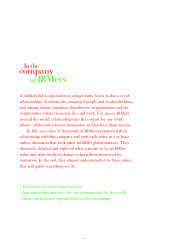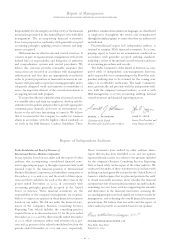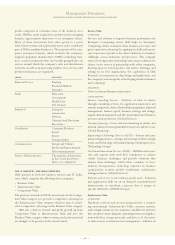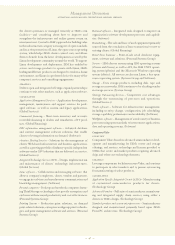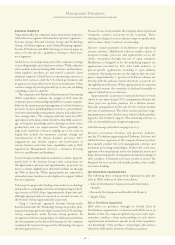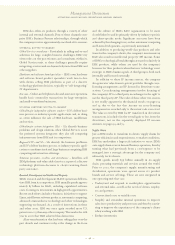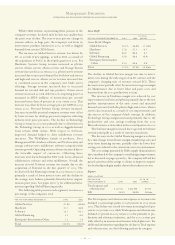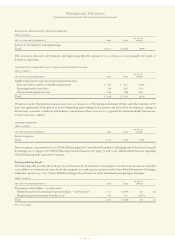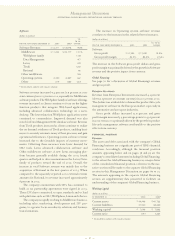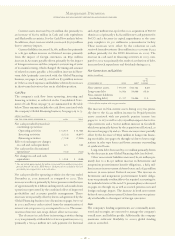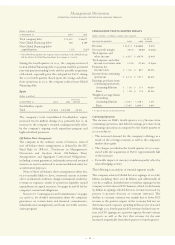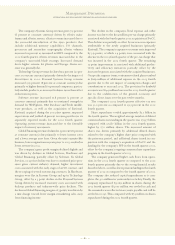IBM 2003 Annual Report Download - page 52
Download and view the complete annual report
Please find page 52 of the 2003 IBM annual report below. You can navigate through the pages in the report by either clicking on the pages listed below, or by using the keyword search tool below to find specific information within the annual report.
The cost savings this unit generates provide two oppor-
tunities for the company: directly improve financial results,
mostly through improved gross profit margins, or improve
competitiveness and market share by passing some or all of
the cost savings to clients. Accordingly, the cost savings gen-
erated by this unit will not always result in a dollar-for-dollar
apparent gross margin improvement in the company’s
Consolidated Statement of Earnings.
While these efforts are largely concerned with product
manufacturing and delivery, IBM is also applying supply
chain principles to service delivery across its solutions and
services lines of business.
By the end of 2003, the work of transforming and integrat-
ing its supply chain resulted in the lowest inventory levels for
IBM in more than 20 years.
In addition to its own manufacturing operations, the
company uses a number of contract manufacturing (CM)
companies around the world to manufacture IBM-designed
products. The use of CM companies is intended to generate
cost efficiencies and reduce time-to-market for certain IBM
products. Some of the company’s relationships with CM
companies are exclusive. The company has key relationships
with Sanmina-SCI for the manufacture of many Intel-based
products and with Solectron for a significant portion of the
manufacturing operations of Global Asset Recovery
Services—an operation of Global Financing that restores
end-of-lease personal computers and other IT equipment for
resale. Further, some IBM-branded products are manufac-
tured by third-party OEMs and then purchased by IBM and
resold under the IBM brand.
KEY BUSINESS DRIVERS
Economic Environment and Corporate IT Spending Budgets
If overall demand for hardware, software and services
changes, whether due to general economic conditions or a
shift in corporate buying patterns, sales performance could
be impacted. IBM’s diverse portfolio of products and offerings
is designed to gain market share in strong and weak economic
climates. The company accomplishes this by not only having
a mix of offerings with long-term cash and income streams as
well as cyclical transaction-based sales, but also by developing
competitive products and solutions, and by effectively man-
aging a skilled resource base.
Internal Business Transformation and Efficiency Initiatives
Key to the success of IBM’s strategy are its ongoing efforts to
drive greater productivity and cost savings as IBM continues
to transform itself into an on demand enterprise. Integral to
these efforts will be the internal supply chain initiatives dis-
cussed above as well as the company’s efforts to manage the
cost of its resources worldwide. These efforts will continue
to include the rebalancing of skills, developing the most
cost-effective workforce structure, and continuing to make
the company’s compensation programs competitive and
aligned with organizational units. The degree of continued
success in this area will impact the amount of company
expense and cost structure improvements, as well as the
amount of competitive leverage it can apply by passing such
savings along to clients.
Technology Innovations
IBM invests for new and innovative products and services.
IBM has been moving away from commoditized categories
of the IT industry and into areas in which it can differentiate
itself through innovation, and by leveraging its investments
in R&D. Examples include IBM’s leadership position in the
design and fabrication of ASICs; the design of smaller, faster
and energy-efficient semiconductor devices (using industry-
leading innovations such as copper technology, silicon on
insulator, silicon germanium, low-K dielectric and nano-
technology); the design of “autonomic” or self-managing
computing systems and “grid” computing networks that allow
computers to share processing power; and the company’s
efforts to advance open technology standards such as Linux.
In the highly competitive IT industry with large diversified
competitors as well as smaller and nimble single-technology
competitors, IBM’s ability to continue its cutting-edge
innovation is critical to maintaining and increasing market
share. IBM is managing this risk by more closely linking its
R&D organization to industry-specific and client-specific
needs, as discussed on page 49.
Open Standards
The broad adoption of open standards is essential to the
computing model for e-business on demand. Without the
open standards that enable all manner of computing platforms
to communicate and work with one another, the integration
of any client’s internal systems, applications and processes
remains a monumental and expensive task. The broad-based
acceptance of open standards—rather than closed, proprietary
architectures—also allows the computing infrastructure to
more easily absorb new technical innovations. IBM is
committed to fostering open standards because they benefit
clients, because they are vital to the on demand computing
model, and because their acceptance will expand growth
opportunities across the entire business services and IT
industry. IBM’s support is evidenced by the enabling of its
products to support open standards such as Linux, as well as
its recent acquisition of Rational. Rational’s software devel-
opment tools can be used to develop and upgrade any other
company’s software products. Accordingly, this acquisition is
a critical part of IBM’s open standards strategy.
Management Discussion
INTERNATIONAL BUSINESS MACHINES CORPORATION AND SUBSIDIARY COMPANIES
50


